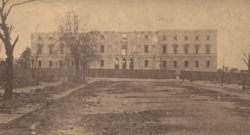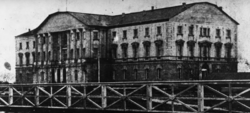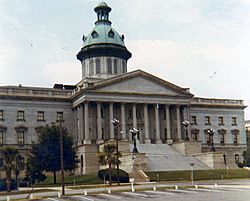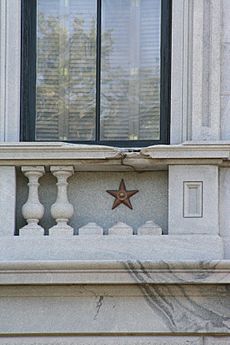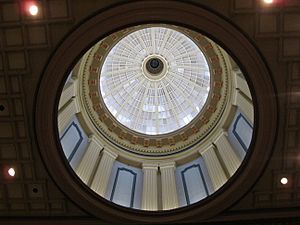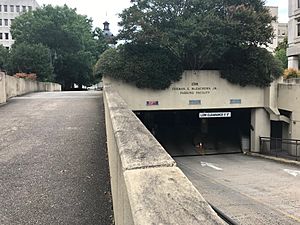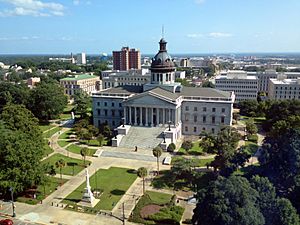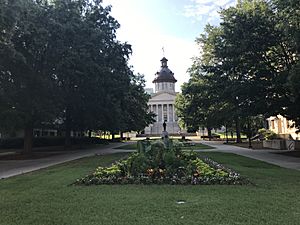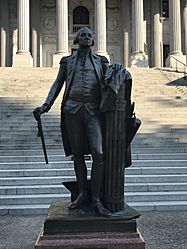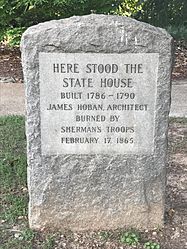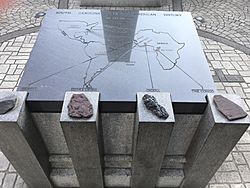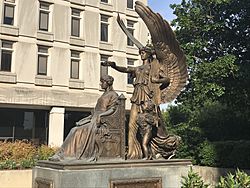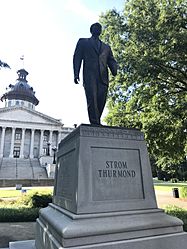South Carolina State House facts for kids
|
South Carolina State House
|
|
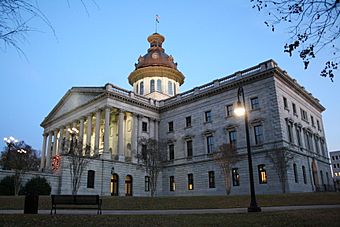
The South Carolina State House
|
|
| Location | 1100 Gervais St., Columbia, South Carolina |
|---|---|
| Built | 1855 |
| Architect | John R. Niernsee; Et al. |
| Architectural style | Classical Revival |
| NRHP reference No. | 70000598 |
Quick facts for kids Significant dates |
|
| Added to NRHP | June 5, 1970 |
| Designated NHL | May 11, 1976 |
The South Carolina State House is a very important building in South Carolina. It is where the state government works. This includes the South Carolina General Assembly, which makes laws. It also holds the offices for the Governor and Lieutenant Governor of South Carolina. You can find this large building in Columbia, the state's capital city.
The State House is built in a style called Classical Revival. It looks like old Greek and Roman buildings. The building is about 180 feet (55 meters) tall. It is also about 300 feet (91 meters) long and 100 feet (30 meters) wide. It is a very big building, weighing more than 70,000 short tons. It has over 130,000 square feet (12,000 square meters) of space inside.
Contents
The First State House
Before the current building, there was an older State House. It was built between 1786 and 1790. An Irish architect named James Hoban designed it. He later became famous for designing the White House in Washington. If you look at old pictures, you can see similarities between the two buildings.
Sadly, the old State House was destroyed. This happened in 1865 during the American Civil War. The city of Columbia was burned, and the old State House was lost.
Looking Back: Historic Photos
- Three images of the modern Statehouse
-
The Statehouse in 1865 after the burning of Columbia during the American Civil War
Building the State House
The current South Carolina State House has a long history of construction.
Early Construction Challenges
Work on the new building started in 1851. The first architect, P. H. Hammarskold, was removed from the project. This was because of problems with his work and materials. Much of what he built had to be taken down.
Building During the Civil War
In 1855, John Niernsee took over as the architect. Construction continued, but it slowed down during the American Civil War. In 1865, General W.T. Sherman's U.S. Army entered Columbia. The city was burned, and many public buildings were destroyed.
The new State House, still being built, was hit by cannon shells. You can still see bronze stars on the building today. These stars mark the spots where the cannonballs hit.
Finishing the State House
After the Civil War, the state was very poor. This made building the State House even slower. The main part of the building was finally finished in 1875.
Later, from 1888 to 1891, Niernsee's son, Frank McHenry Niernsee, continued the work. He helped finish much of the inside of the building. The exterior was finally completed in 1907 by architect Charles Coker Wilson. The State House has also had updates in 1959 and 1998.
In 1976, the State House was named a National Historic Landmark. This means it is a very important place in American history.
State House Grounds and Monuments
The land around the State House is called its grounds. Many statues and monuments are placed here. These monuments honor important people and events in South Carolina's history.
Notable Monuments
- Confederate Monument: This monument is on the north side of the building. It used to have a Confederate battle flag flying nearby. The flag was moved in 2000 and then removed from the grounds in 2015. This happened after a state law was passed.
- African-American History Monument: This monument was unveiled in 2001. It honors the history and contributions of African Americans in South Carolina.
- President George Washington: A bronze statue of the first U.S. President. It was bought by South Carolina in 1857.
- Revolutionary War Generals: This monument honors three important generals from the American Revolutionary War: Andrew Pickens, Thomas Sumter, and Francis Marion.
- Palmetto Regiment: This monument is a cast iron and copper palmetto tree. It honors a military group from South Carolina.
- Wade Hampton III: A large bronze statue of Hampton, who was a Confederate general and later a South Carolina governor and U.S. Senator.
- South Carolina Soldiers Monument: A memorial honoring Confederate soldiers.
- Monument to South Carolina Women of the Confederacy: This monument honors the women who supported the Confederacy.
- James F. Byrnes: A monument to this politician who served South Carolina for many years.
- Strom Thurmond: A statue honoring the former South Carolina governor and U.S. Senator. The names of his children, including Essie Mae Washington-Williams, are on the inscription.
- Benjamin Tillman: A monument to a U.S. Senator. This monument is seen as controversial by some.
- Dr. J. Marion Sims: A monument to a physician who was a pioneer in gynecology. This monument is also seen as controversial by some.
- Law Enforcement Memorial: This memorial, built in 2005, honors police officers who died while on duty in South Carolina.
Captain Swanson Lunsford, an officer from the American Revolutionary War, is also buried on the State House grounds. He owned some of the land where the State House now stands.
State House Grounds Gallery
- Images of statues on the Statehouse Grounds
-
The plaque beneath Washington's statue reads about damage during the Civil War.
-
A gun from the U.S.S. Maine, a ship that sank at the start of the Spanish–American War.
-
A depiction of the slave trade to Charleston, SC.
-
A memorial to the women of the Confederacy.
-
A statue of Strom Thurmond.
See also
 In Spanish: Casa del Estado de Carolina del Sur para niños
In Spanish: Casa del Estado de Carolina del Sur para niños


